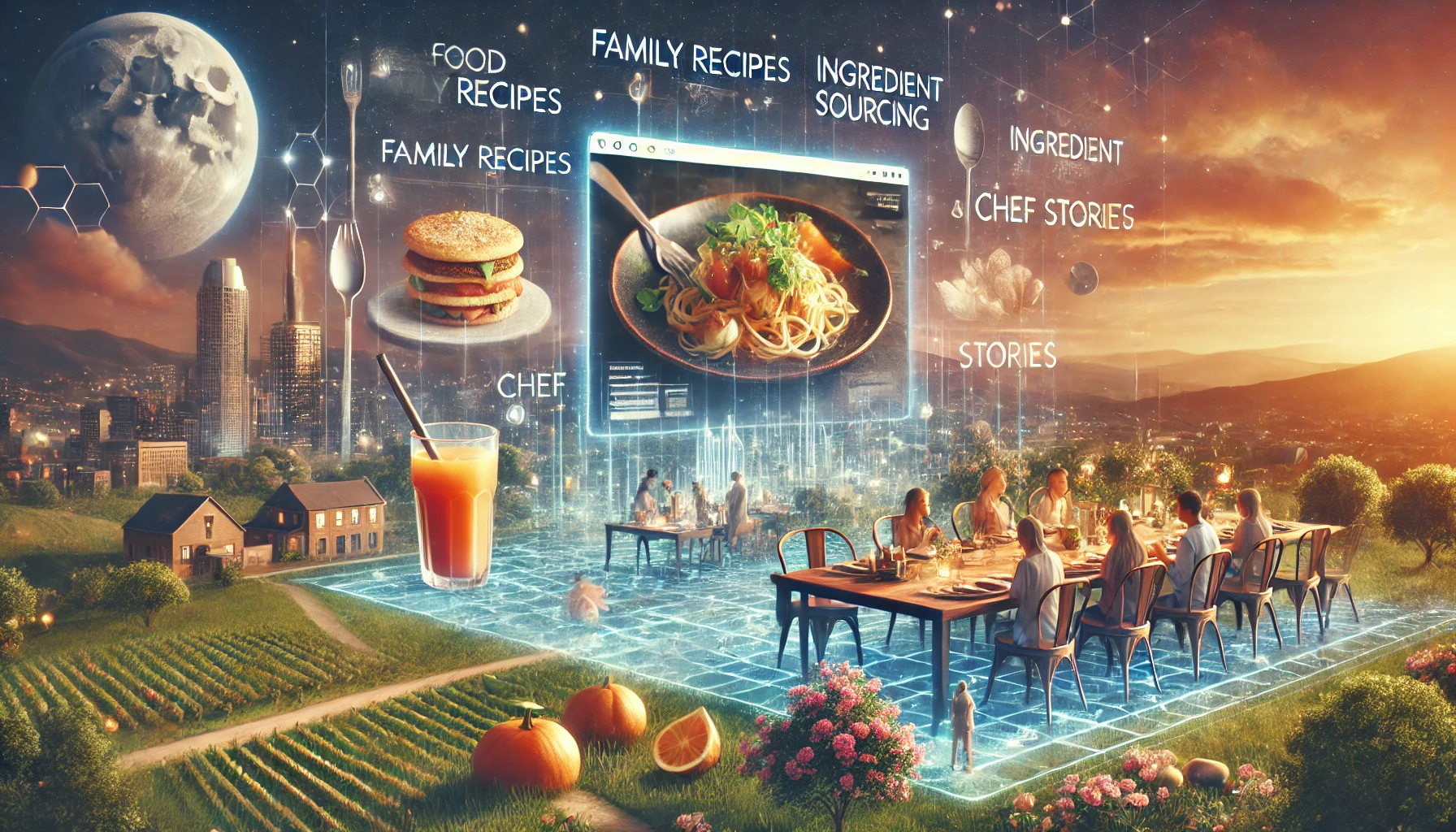Imagine biting into a perfectly crafted dish—each flavour thoughtfully balanced, textures complementing one another, and the presentation making it almost too beautiful to eat. Now, picture a well-designed website.
The colours pop, the layout flows effortlessly, and the user experience (UX) feels just right. Coincidence? Not at all! The worlds of food and web design have more in common than you might think.
Much like a chef curates ingredients for the ultimate dining experience, web designers blend visual elements, interactive features, and branding to create a seamless online journey.
The same principles that make a dish irresistible—presentation, balance, and sensory appeal—are at the heart of compelling website design.
In this post, we’ll explore how food inspires digital branding, UX, and aesthetic appeal. From the psychology of colour to the art of plating (or page layout!), you’ll discover why a great website, much like a great meal, is a feast for the senses.
For more insights on digital branding and marketing, visit SpoonFed Atlanta.
Cooking Up a Strong Visual Identity in Web Design
Just as a restaurant’s ambience sets the stage for a dining experience, a brand’s web design should capture the essence of its culinary identity. Whether it’s a high-end fine dining establishment or a quirky food truck, the visual elements of a website must communicate the brand’s personality, values, and, of course, its mouth-watering offerings.
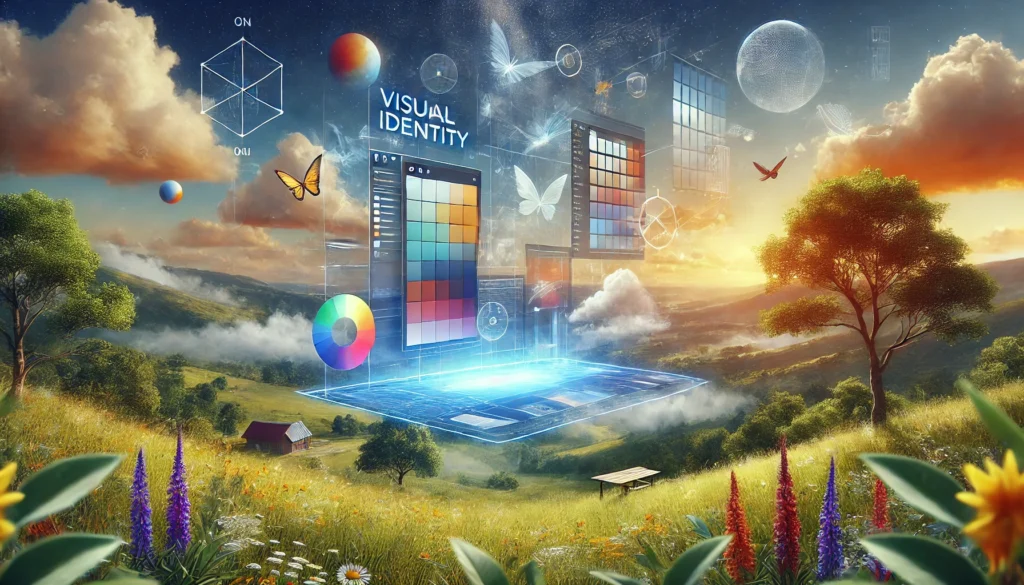
The Psychology of Colour in Food Branding
Colour is one of the most powerful tools in both food and web design. Ever noticed how many fast-food chains use red and yellow in their branding? That’s no accident—red stimulates appetite, while yellow evokes feelings of happiness and warmth. On the other hand, organic and health-focused brands often lean towards greens and earthy tones, reinforcing freshness and natural ingredients.
For food-related websites, colour choice should align with the emotions and cravings the brand wants to evoke:
- Red & Orange – Energy, appetite stimulation (e.g., McDonald’s, KFC)
- Green & Brown – Freshness, sustainability, natural ingredients (e.g., Whole Foods, Panera Bread)
- Blue & Purple – Unusual in food branding, but can signal innovation or luxury (e.g., Cadbury’s purple packaging)
By strategically incorporating these colours into a website’s palette, designers can influence customer perceptions and even purchasing behaviour. For more on colour psychology in branding, check out this guide on colour theory.
The Font Menu: Typography’s Impact on Brand Perception
Typography is like the seasoning of a website—too little, and it feels bland; too much, and it’s overwhelming. The choice between serif and sans-serif fonts plays a huge role in shaping brand identity:
- Serif Fonts (e.g., Times New Roman, Garamond) – Often associated with tradition, elegance, and high-end dining experiences. Perfect for a Michelin-starred restaurant or an artisanal bakery.
- Sans-Serif Fonts (e.g., Helvetica, Montserrat) – Clean, modern, and approachable. Ideal for casual cafés, trendy food blogs, and delivery services.
- Script & Handwritten Fonts – Bring a personal, homemade feel, great for boutique bakeries and small-batch food brands.
The right typography doesn’t just make a website readable—it adds personality, making the brand more memorable and engaging.
A Picture Is Worth a Thousand Bites: The Role of High-Quality Food Imagery
Imagine reading a restaurant menu without pictures—now imagine a food website without vibrant, high-quality imagery. Stunning visuals are essential in food branding because we “eat” with our eyes first. A great food website should feature:
- Close-up shots that highlight textures, freshness, and richness.
- Minimalist backgrounds to let the food shine.
- Consistent aesthetic that matches the brand’s personality (rustic, modern, playful, etc.).
- Motion elements, like steam rising from a cup of coffee or a perfectly oozing cheese pull, to make the visuals feel alive.
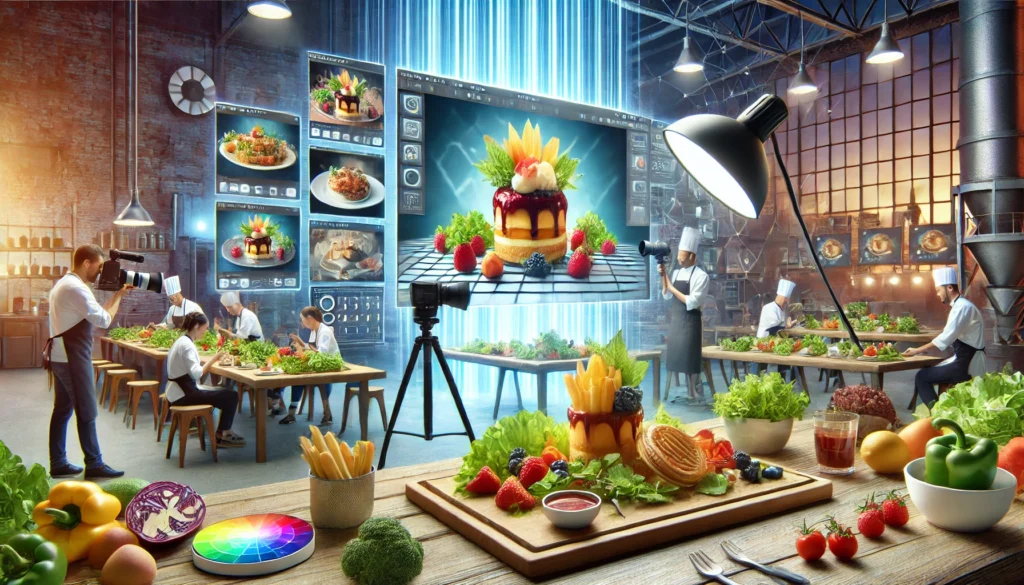
Incorporating high-quality images into web design enhances digital engagement, increases conversions, and makes visitors crave what’s on the menu—literally! For expert food photography tips, check out this resource.
User Experience & Sensory Design
Great food isn’t just about taste—it’s about presentation, texture, and the overall dining experience. The same applies to web design. A beautifully designed website should not only look appealing but also provide a seamless, engaging user experience (UX).
User Experience: Serving Up Functionality Without the Clutter
Ever been to a fine dining restaurant where every element on the plate is placed with intention? Each drizzle of sauce, each garnish—it all serves a purpose. The same philosophy applies to structured website layouts. Cluttered pages with too many elements can overwhelm visitors, just like a chaotic plate of food can ruin an otherwise great dish.
The Perfectly Plated Website Layout
Just like plating techniques in fine dining focus on balance, contrast, and hierarchy, web designers must arrange content in a way that guides the user’s eye naturally. Effective website layouts follow these key principles:
- Whitespace is like negative space on a plate – It allows key elements to stand out.
- Balance between text and visuals – Too much of either disrupts harmony.
- A clear focal point – Whether it’s a bold call-to-action (CTA) or a stunning hero image, something should immediately draw attention.
Menus & Navigation: The Website’s Main Course
A well-structured restaurant menu makes ordering easy; a confusing one makes diners frustrated. The same goes for website navigation. A food website should offer:
- Intuitive structure – Navigation should be simple, predictable, and easy to follow.
- Descriptive labels – Clear wording helps users find what they need fast. (E.g., “Our Menu” is better than “Explore.”)
- Logical categorisation – Just like appetisers, mains, and desserts, website sections should be logically grouped.
A great website menu ensures that visitors don’t feel lost—just like a well-designed restaurant menu encourages diners to order without second-guessing.
The Balance Between Beauty & Functionality
A website should be like a beautifully plated dish: stunning, but also practical. Overloading a site with excessive animations, oversized images, or slow-loading elements can make it look fancy but frustrating to use. A successful UX finds the perfect balance—delivering an aesthetically pleasing experience without compromising speed and usability.
Sensory Design: Engaging All the Digital Taste Buds
Food is a multi-sensory experience—it’s not just about taste, but also sight, smell, and texture. While websites can’t yet transmit flavours or aromas (we wish!), they can create a sensory-rich experience that mimics real-world dining.
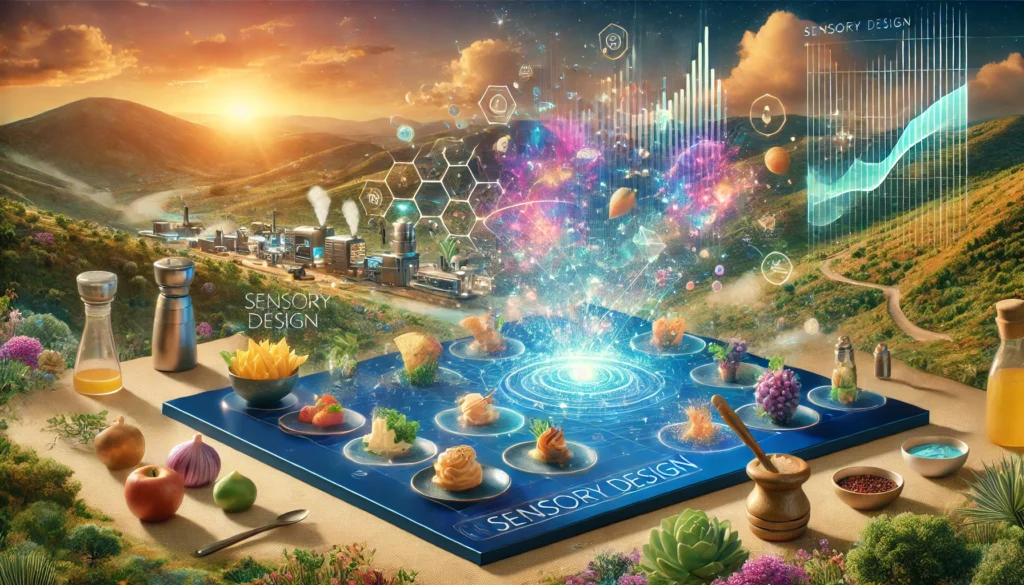
Colour, Layered Images & Textures: Making Design Feel Tactile
Just as food presentation relies on depth and contrast, web design uses:
- Layered visuals to create depth, mimicking textures in food photography.
- Soft gradients & shadows to replicate the richness of real-world objects.
- Tactile design elements like rough, rustic backgrounds for artisanal brands or sleek, polished aesthetics for modern cuisine.
These details make digital design feel more immersive—almost as if the food is right in front of you.
Video & Motion Graphics: Bringing Food to Life
Few things make a food website more enticing than well-placed motion:
- Slow-motion drizzles of chocolate
- Flames rising from a sizzling grill
- A perfect espresso pour filling up the screen
Motion graphics don’t just add aesthetic appeal; they create an emotional connection, making the food feel more real and inviting.
Multimedia & ASMR: The Sound of Flavour
Ever heard the satisfying crunch of a fresh baguette or the gentle bubbling of a simmering sauce? These sounds trigger sensory memories that make food more tempting. More websites are integrating:
- Subtle background sounds like coffee shop ambience.
- ASMR-style interactions where hovering over an image triggers a faint sizzling or pouring sound.
- Click & swipe sound effects to make the experience feel more dynamic.
By engaging multiple senses, web designers can make food websites feel more immersive—almost as if visitors can taste what’s on the screen.
SEO, Speed & Accessibility
A visually stunning food website may entice visitors, but if it loads too slowly or isn’t accessible, potential customers might click away before even seeing that drool-worthy burger or artisanal cake. Finding the perfect balance between aesthetics, performance, and inclusivity is key to creating a site that satisfies both users and search engines.
SEO and Speed: The Fine Balance of Performance & Presentation
Food websites, especially those rich in high-resolution images and videos, often struggle with page speed. Slow-loading pages frustrate visitors and can negatively impact SEO rankings. Since Google prioritises fast-loading sites in search results, optimising performance is essential.
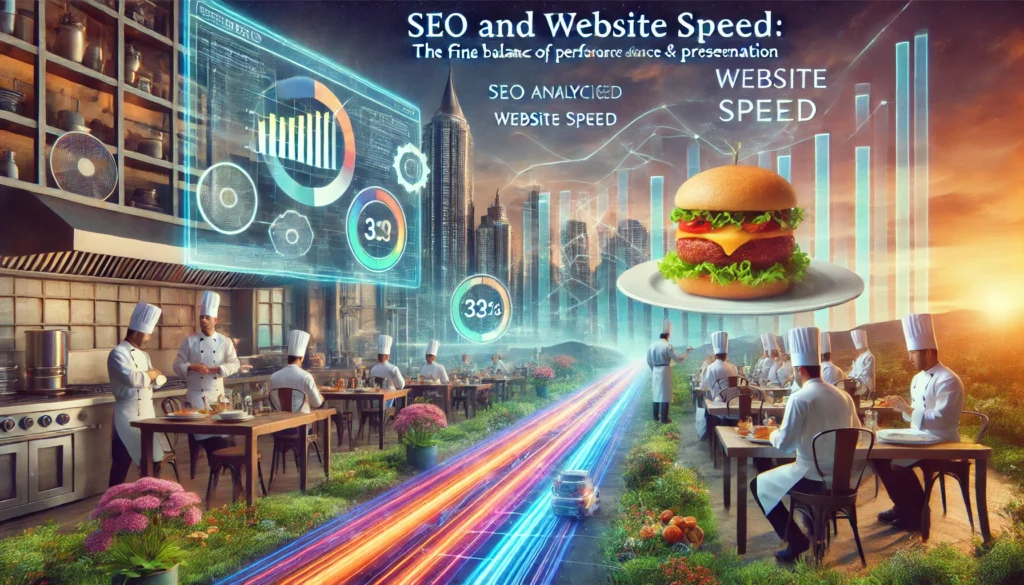
Why Food Websites Face Speed Issues
- High-resolution images – While stunning visuals are a must, large file sizes slow down page load times.
- Autoplay videos & animations – While engaging, they can cause lag if not optimised.
- Complex design elements – Parallax scrolling, layered effects, and heavy scripts can increase load times.
Solutions for Faster, More Efficient Web Performance
- Image compression – Use tools like TinyPNG or WebP format to reduce file sizes without losing quality.
- Lazy loading – Load images only when they come into view, reducing initial load times.
- Content Delivery Networks (CDNs) – Distribute content across multiple servers for faster access.
- Optimised caching – Store common elements locally so returning visitors experience faster loading.
By implementing these techniques, food websites can maintain their visual appeal without sacrificing performance. For more SEO strategies tailored to food businesses, visit SpoonFed Atlanta’s SEO insights.
Recipe Blogs vs. E-Commerce Food Sites: Different SEO Needs
Not all food websites are the same—SEO strategies vary depending on the type of content they offer:
| Website Type | Key SEO Considerations |
| Recipe Blogs | Long-form content, structured data for recipes, keyword-rich headings. |
| E-Commerce Food Sites | Fast loading, mobile optimisation, high-quality but lightweight product images. |
Recipe blogs thrive on SEO-friendly content, using structured data markup for search engines to display rich snippets (like cooking time and star ratings). Meanwhile, food e-commerce sites prioritise product pages, fast transactions, and mobile-first design to boost conversions.
Accessibility: Serving Every Visitor With Inclusive Design
A great website should be accessible to everyone, regardless of ability. Unfortunately, many food-related websites overlook basic accessibility features, making it difficult for some users to browse menus, read recipes, or order food.
Common Accessibility Issues in Food Web Design
- Poor colour contrast – Text that blends into the background makes reading difficult.
- Missing alt text – Screen readers can’t describe images without alternative text.
- Complicated navigation – Unclear menus or links that don’t work well with keyboard navigation.
- Auto-playing media without controls – Videos and sounds should have options to pause or mute.
Best Practices for an Inclusive Food Website
- Use high-contrast fonts – Ensure text is easy to read against background colours.
- Add alt text to all images – Describe food images in a way that screen readers can convey.
- Ensure keyboard-friendly navigation – Users should be able to browse without relying on a mouse.
- Provide text alternatives for multimedia – Include captions for videos and transcriptions for audio.
Making a website accessible isn’t just about compliance—it’s about welcoming every visitor to the digital dining table. After all, food is for everyone, and so should be the experience of exploring it online. For a deeper dive into website accessibility, check out W3C’s Web Accessibility Initiative.
Emotional Engagement in Food-Based Web Design
Food is more than just sustenance—it’s a source of comfort, nostalgia, and connection. The best food websites don’t just sell a product; they tell a story, evoke emotion, and make users crave more.
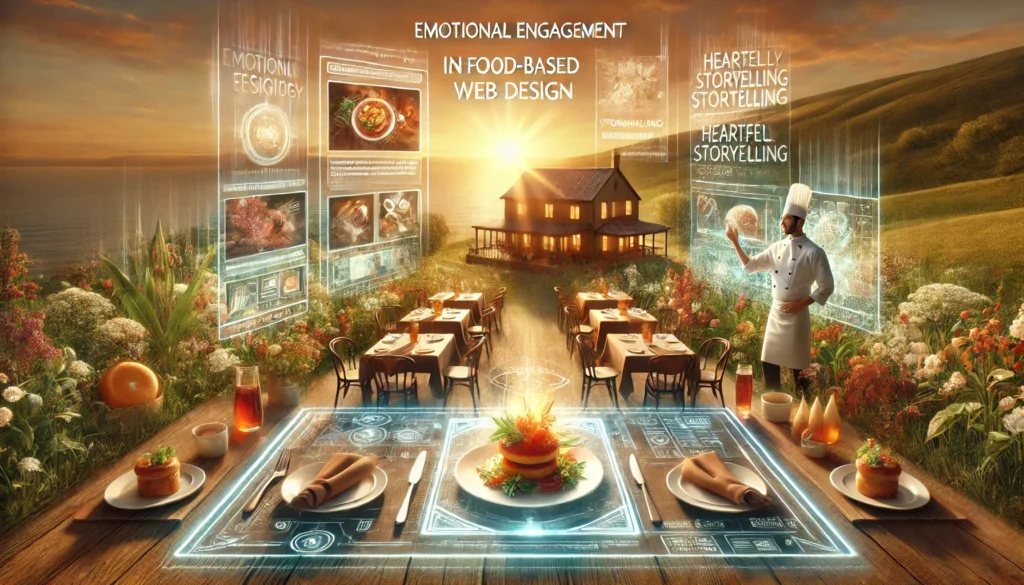
Emotional Engagement: Making Users Hungry for More
A well-designed food website should do more than display menus and prices—it should spark an emotional connection. Studies show that emotions play a huge role in decision-making, especially when it comes to food. Whether it’s the warmth of a homemade meal or the thrill of discovering an exotic dish, emotional engagement can turn casual visitors into loyal customers.
Famous Food Brands That Master Emotional Storytelling
Some of the most successful food brands build their identity around emotions:
- Coca-Cola – Happiness, nostalgia, and shared moments (e.g., holiday campaigns featuring families and friends).
- Ben & Jerry’s – Whimsical branding with a focus on social responsibility and feel-good indulgence.
- McDonald’s – Family-friendly branding that evokes comfort, familiarity, and childhood memories.
These brands don’t just sell food; they sell experiences, memories, and emotions.
The Power of Descriptive Copywriting
Words can be just as appetising as images when used correctly. Descriptive copywriting enhances emotional engagement by making food tangible through language. Compare these two descriptions:
“Try our new burger—it’s delicious!” (generic, uninspiring)
“Sink your teeth into our juicy, flame-grilled beef patty, perfectly nestled between a toasted brioche bun, with crispy bacon and a rich, smoky BBQ glaze.” (evokes taste, texture, and smell)
By using sensory-driven words, food websites can stimulate cravings before users even see the menu.
How to Use Storytelling in Food-Based Web Design
Every great dish has a story, and every successful food brand knows how to tell one. Storytelling in web design helps brands build trust, create deeper engagement, and differentiate themselves in a crowded market.
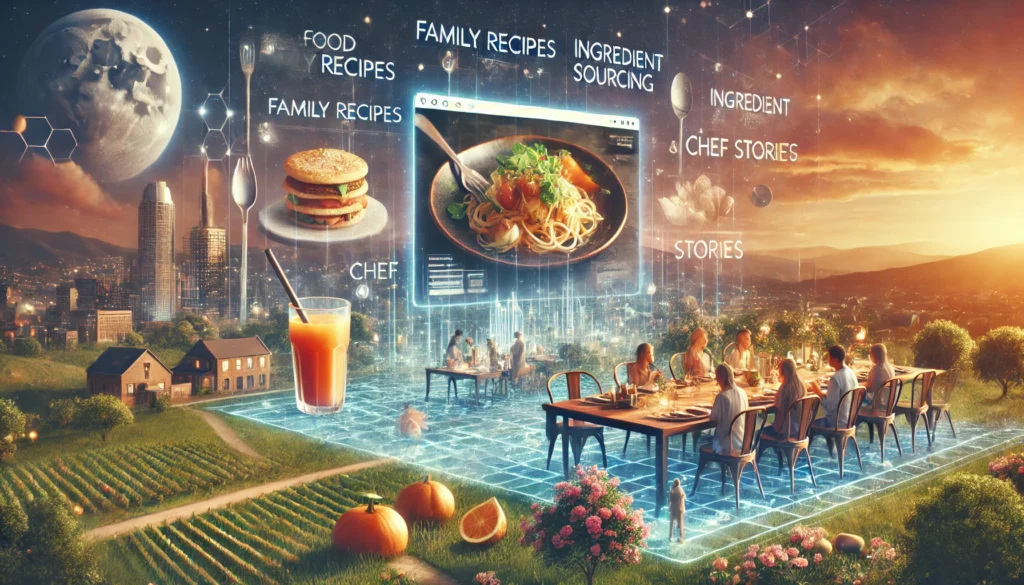
Why Storytelling Matters in Food Branding
- Authenticity sells – Consumers connect with brands that share their values.
- A good story sticks – People remember narratives better than plain facts.
- Stories build trust – Showing the journey behind a product makes it more relatable.
For example, a family-owned bakery might share how a secret recipe has been passed down for generations, while a sustainable coffee brand could highlight its ethical sourcing practices. These stories give the brand depth and character.
Visuals, User-Generated Content & Testimonials: Building Community Trust
Engaging storytelling isn’t just about words—it’s about creating an immersive brand experience. Successful food brands incorporate:
- Behind-the-scenes videos – Show how dishes are made, from farm to plate.
- Customer testimonials – Real stories from satisfied customers create credibility.
- User-generated content – Social media posts featuring real people enjoying the food build authenticity.
Examples of Engaging Storytelling Elements
- Ingredient sourcing journeys – A coffee brand showcasing its farmers and ethical trade practices.
- Restaurant origins – A chef’s personal journey that inspired their signature dish.
- Cultural significance – A brand explaining the history behind a traditional recipe.
By weaving together images, words, and real customer experiences, food brands can craft a website that doesn’t just inform—it connects.
Keeping Up with Web Design Trends
Just like food trends evolve—from molecular gastronomy to plant-based dining—web design trends are constantly shifting. A modern, engaging food website needs to stay ahead of the curve, embracing the latest digital innovations to remain fresh and appealing.

Keeping Up with Trends: What’s Cooking in the Web Design World?
With more consumers discovering, ordering, and even experiencing food online, digital-first branding is more important than ever. From immersive visuals to AI-driven personalisation, today’s web design trends shape how users interact with food brands in the digital space.
Popular Design Trends in Food Websites
1. Sustainable & Earthy Colour Palettes – Eco-conscious dining is on the rise, and food brands are reflecting this through warm, natural tones. Expect to see:
- Soft greens, browns, and organic textures for farm-to-table brands.
- Muted pastels and minimalist designs for artisanal bakeries and cafés.
2. Bold Typography & High-Contrast Text – Typography is playing a bigger role in food branding, with:
- Large, expressive fonts that add personality.
- Handwritten or vintage-inspired typography to evoke authenticity and nostalgia.
3. Immersive & Story-Driven Experiences – Websites are moving beyond static images with:
- Full-screen background videos showcasing dishes being prepared.
- Interactive elements like parallax scrolling reveal stories behind ingredients.
The Rise of AI & Personalisation in Food Web Design
AI-driven personalisation is reshaping how users engage with food brands online. Key innovations include:
- Dynamic menus that suggest items based on browsing history.
- Chatbots & virtual assistants to recommend dishes and answer customer queries.
- AI-powered recipe recommendations tailored to dietary preferences.
From smart food ordering platforms to interactive virtual cooking assistants, AI is making food-based web design more intuitive, responsive, and engaging than ever before.
Final Plating: Bringing It All Together
Just like a perfectly plated dish, great web design is all about balance, presentation, and emotional appeal. Throughout this post, we’ve explored how the world of food influences branding, UX, accessibility, and digital storytelling.
From the psychology of colour to the art of sensory engagement, food-based web design goes beyond aesthetics—it creates experiences that make users crave, connect, and convert.
Food and web design share the same core principles: visual harmony, emotional engagement, and the power of storytelling.
Whether it’s a minimalist fine-dining website or a bold, vibrant food truck page, the goal is the same—to capture attention and leave a lasting impression. So why settle for a bland digital presence when you can serve up a masterpiece?
Your Turn: What’s on Your Digital Menu?
Think about the most mouth-watering food website you’ve ever seen—what made it stand out? Was it the high-quality imagery, the immersive storytelling, or the seamless navigation?
Now, it’s time to bring that inspiration to your own projects! Whether you’re revamping a restaurant website, launching a food blog, or crafting an e-commerce platform for artisanal goods, let culinary creativity guide your design choices. Dare to experiment, mix bold flavours, and make your digital presence as enticing as a five-star meal.
Hungry for more inspiration? Visit SpoonFed Atlanta for expert insights on digital branding, food marketing, and web design trends. Let’s cook up something amazing together!
